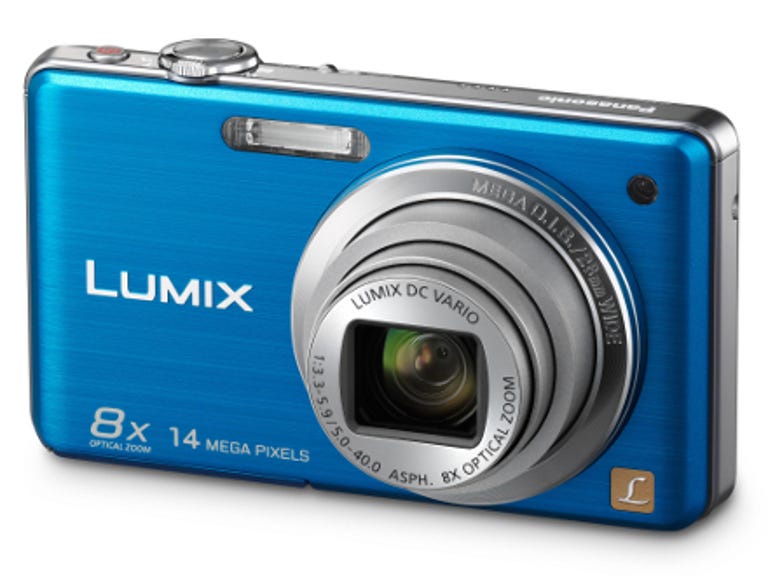 Why You Can Trust CNET
Why You Can Trust CNET Panasonic Lumix DMC-FS30 review: Panasonic Lumix DMC-FS30
The Panasonic Lumix DMC-FS30 is a competent compact camera, with an 8x zoom. There's nothing revolutionary about it, but it lets you point, shoot and get decent results with minimal fuss.
Compact cameras that pack impressive zoom power are all the rage. Such devices are arguably a must-have for anyone heading abroad who wants to travel light but still capture decent photos. Panasonic has led the charge with its impressive TZ-series models, and now it's packing big zooms into its 'fashion and style' FS range.
The Good
The Bad
The Bottom Line
But, when the compact Lumix DMC-FS33 landed at CNET UK recently, we found a fair few flaws. Will its more modest sibling, the Lumix DMC-FS30, fare better? It dispenses with its sibling's touchscreen and is slightly more affordable, at around £140.
Touchscreen be gone
In the past, we've never been totally convinced by Panasonic's 'best of both worlds' approach with its FS-series cameras that paired a touch-sensitive screen with physical controls. It came across as something of a gimmick, as you couldn't wholly rely on the touchscreen.

There's none of that nonsense with the metal and plastic FS30. There's very little temptation to touch the 69mm (2.7-inch), 230,000-pixel screen. It's a boxy camera with decently sized buttons. If you gave a child a crayon and asked them to draw a camera, they'd probably come up with something resembling the FS30. What you see is what you get.
The FS30 also packs a 14.1-megapixel resolution and a folded, optically stabilised, 8x zoom into its otherwise unassuming exterior. You don't get an HDMI output, which would help you make the most of its 720p, hi-def, 30fps video-shooting capability, but the camera does offer standard AV and USB outputs.
The FS30 feels solid. With a weight of 162g and dimensions of 100 by 57 by 28mm, it slips readily into a trouser pocket or handbag.
It takes just over a second to power up the camera, ready for the first shot. As with the FS33, the FS30's focal range is a wide-angle 28-224mm in 35mm film terms. The lens retracts into the body and is protected by a sliding cover when powered down.
The FS30 also has the same 14.1-megapixel, 1/2.33-inch CCD sensor at its core. It offers 40MB of internal storage, allowing up to 15 images to be shot and saved, so you'll want to expand the memory with an SD, SDHC or SDXC card. Committing a maximum-resolution JPEG to memory takes all of 3 seconds, which is average for this class of camera.
Easy to use
Operating the FS30 is simplicity itself. A dedicated 'intelligent auto' button on the top plate allows you to disengage your brain, and just point and shoot. Press this button and the camera will do its best to recognise common scenes and subjects and adjust the settings accordingly, to deliver optimum results. This mode is pretty effective, unless presented with busy scenes.
The other capture modes, video included, are selected via a press of the mode button on the back plate. That button falls under the thumb, with your forefinger poised over the springy shutter-release button, which is encircled by the zoom lever.
The FS30 offers an 'extra optical zoom' feature, which extends the existing zoom range to 16.9x if desired. Unfortunately, the trade-off is that the resolution drops to 3 megapixels -- the camera is only using the central part of its CCD sensor, so in effect performing a crop.
Besides its marginally different specification, how does the FS30 compare with the FS33 in terms of operation? One practical feature of the FS33 that we missed was the way you could adjust the positioning of the autofocus point by tapping the screen with a fingernail. In the case of the FS30, you have to resort to the usual method of pointing the camera at the subject you want to focus on, pressing the shutter button down halfway, and recomposing the frame before pressing the shutter release fully.
The FS33's 'quick menu' button will save you some time, though. It provides speedy access to key shooting settings via a toolbar, so you don't have to wade through the menu system.
Conclusion
Given its price, we were impressed by the sharp results achievable with the Panasonic Lumix DMC-FS30. Noise only really becomes a problem above ISO 800, colours are warm, and, although shots taken at maximum zoom can look slightly soft, that's to be expected. The FS30 isn't perfect, but it's better than its modest pricing would suggest.
Edited by Charles Kloet
